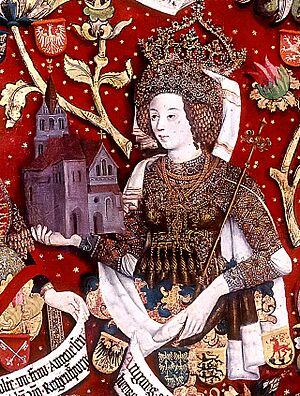Agnes of Waiblingen facts for kids
Quick facts for kids
Agnes of Waiblingen
|
|
|---|---|
| Duchess consort of Swabia Margravine consort of Austria |
|

Margravine Agnes, Babenberg family tree, Klosterneuburg Monastery, c. 1490
|
|
| Born | 1072 |
| Died | 24 September 1143 (aged 70–71) Klosterneuburg |
| Noble family | Salian |
| Spouse(s) |
|
| Issue |
|
| Father | Henry IV, Holy Roman Emperor |
| Mother | Bertha of Savoy |
Agnes of Waiblingen (born 1072 or 1073 – died 24 September 1143) was an important princess from the Salian dynasty. She was also known as Agnes of Germany or Agnes of Franconia. Through her first marriage, she became the Duchess of Swabia. Later, through her second marriage, she became the Margravine of Austria.
Her Family Background
Agnes was the daughter of Henry IV, Holy Roman Emperor, and Bertha of Savoy. She was named after her grandmother, Agnes of Poitou. She had two brothers, Conrad and Henry. Sadly, two other siblings, Adelaide and Henry, passed away when they were very young. Agnes was about 15 years old when her mother died. A couple of years later, her father married again to Eupraxia of Kiev.
First Marriage
In 1079, when Agnes was just seven years old, she was promised in marriage to Frederick. He was a member of the Hohenstaufen family. At the same time, Agnes's father, Emperor Henry IV, made Frederick the new duke of Swabia.
Agnes and Frederick were married in 1086, when she was fourteen. They had several children together:
- Frederick II of Swabia
- Conrad III of Germany
- Gertrud, who married Hermann III, Count Palatine of the Rhine
- Heilika, who married Frederick III of Pettendorf-Lengenfeld-Hopfenche
- Richildis, who married Hugh I, Count of Roucy
Second Marriage
After Frederick passed away in 1105, Agnes married Leopold III. He was the Margrave of Austria from 1095 to 1136.
There's a story that says Agnes lost her veil while hunting. Years later, Leopold found it, and this event inspired him to build the Klosterneuburg Monastery.
Agnes and Leopold had many children:
- Adalbert
- Leopold IV
- Henry II of Austria
- Berta, who married Heinrich III, Burgrave of Regensburg
- Agnes, who was known for her beauty and married Wladyslaw II of Poland
- Ernst
- Uta, who married Luitpold I, Count of Plain
- Otto of Freising, who became a bishop and a writer
- Conrad, who became a bishop and later an archbishop
- Elisabeth, who married Hermann, Count of Winzenburg
- Judith, who married William V of Montferrat. Their children became important leaders in the Crusades.
- Gertrude, who married Vladislav II of Bohemia
In 1125, Agnes's brother, Henry V, Holy Roman Emperor, died without any children. This meant that Agnes and her children inherited a lot of valuable land and property from the Salian dynasty, including the area of Waiblingen.
In 1127, Agnes's second son, Konrad III, was chosen by some groups to be the King of Germany. Later, when the previous king, Lothar, died in 1137, Konrad was officially elected as the King of Germany.
Sources
- Karl Lechner, Die Babenberger, 1992.
- Brigitte Vacha & Walter Pohl, Die Welt der Babenberger: Schleier, Kreuz und Schwert, Graz, 1995.
- Ancestral Roots of Certain American Colonists Who Came to America Before 1700 by Frederick Lewis Weis, Line 45-24
- H. Decker-Hauff, Die Zeit der Staufer, vol. III (Stuttgart, 1977).

